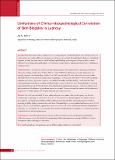Please use this identifier to cite or link to this item:
https://hdl.handle.net/20.500.14356/2011Full metadata record
| DC Field | Value | Language |
|---|---|---|
| dc.contributor.author | Karki, S | - |
| dc.contributor.author | Jha, R | - |
| dc.date.accessioned | 2023-06-05T09:32:40Z | - |
| dc.date.available | 2023-06-05T09:32:40Z | - |
| dc.date.issued | 2010 | - |
| dc.identifier.citation | KarkiS., & JhaR. (2010). Limitations of Clinico-histopathological correlation of Skin Biopsies in Leprosy. Journal of Nepal Health Research Council. https://doi.org/10.33314/jnhrc.v0i0.222 | en_US |
| dc.identifier.issn | Print ISSN: 1727-5482; Online ISSN: 1999-6217 | - |
| dc.identifier.uri | http://103.69.126.140:8080/handle/20.500.14356/2011 | - |
| dc.description | Original Article | en_US |
| dc.description.abstract | Abstract Background: Skin biopsies play an important role in diagnosing and classifying different types of leprosy. The aim of this study was to analyse different histologic types of leprosy, to correlate histopathological diagnosis with clinical diagnosis, to study the uniformity of clinical and histological findings in the diagnosis of leprosy and to evaluate difficulties faced during clinicopathological correlation according to Ridley- Jopling classification due to inadequacy of data provided. Methods: This is a retrospective study of all skin biopsies reported from Department of Pathology of Tribhuvan University Teaching Hospital from 14 April 2007 to 13 April 2009, for which leprosy was the diagnosis or was strongly suspected on histopathology. Results: Out of 40 cases included, 33 were males and seven were females.           Tuberculoid leprosy was the most common type comprising 23/40 cases (57.5%). In 18/40 cases (45%), clinical diagnosis was leprosy. Only in three, leprosy was classified according to Ridley-Jopling criteria clinically. Thus clinicopathological correlation according to Ridley-Jopling criteria could not be done. Histopathological reporting lacked uniformity too. In 13/40 reports (32.5%), exact location of granuloma, presence or absence of Grenz zone and encroachment of epidermis by granuloma was  not mentioned. None mentioned the number and distribution of lymphocytes or relative proportion of  epithelioid cells and foamy histiocytes. Results: Out of 40 cases included, 33 were males and seven were females. Tuberculoid leprosy was the most common type comprising 23 /40 cases (57.5%). In 18/ 40 cases (45%), clinical diagnosis was leprosy. Only in three, leprosy was classified according to Ridley-Jopling criteria clinically. Thus clinicopathological correlation according to Ridley-Jopling criteria could not be done. Histopathological reporting lacked uniformity too. In 13/40 reports (32.5%), exact location of granuloma, presence or absence of Grenz zone and enroachment of epidermis by granuloma was not mentioned. None mentioned the number and distribution of lymphocytes or relative proportion of epithelioid cells and foamy histiocytes. Conclusions: Histopathological diagnosis of leprosy did not correlated with clinical diagnosis significantly. Uniformity was not seen in the clinical or histopathological informations provided making it difficult to conduct retrospective clinic pathological correlation. Key words: granuloma, histopathology, leprosy, Ridley-Jopling classification, tuberculoid | en_US |
| dc.language.iso | en | en_US |
| dc.publisher | Nepal Health Research Council | en_US |
| dc.relation.ispartofseries | April, 2010;222 | - |
| dc.subject | Granuloma | en_US |
| dc.subject | Histopathology | en_US |
| dc.subject | Leprosy | en_US |
| dc.subject | Ridley-Jopling classification | en_US |
| dc.subject | Tuberculoid | en_US |
| dc.title | Limitations of Clinico-histopathological correlation of Skin Biopsies in Leprosy | en_US |
| dc.type | Journal Article | en_US |
| local.journal.category | Original Article | - |
| Appears in Collections: | Vol 8 No 1 Issue 16 April 2010 | |
Files in This Item:
| File | Description | Size | Format | |
|---|---|---|---|---|
| 222-Article Text-220-1-10-20130822.pdf | Fulltext Download | 184.57 kB | Adobe PDF |  View/Open |
Items in DSpace are protected by copyright, with all rights reserved, unless otherwise indicated.
